With the rising popularity of veganism among travelers, the vibrant realm of Vegan Vietnamese Food awaits exploration. Dive into the rich tapestry of Vietnamese cuisine while staying true to your dietary preferences. Join us as we embark on a delectable journey that caters to your tastes and values.
See more: Vegan in Vietnamese – Discover the Wonders of Plant-Based Cuisine
Exploring Vegan Vietnamese Menus
Vegan Vietnamese cuisine offers a diverse and fascinating array of dishes deeply embedded in Vietnamese culture. From nourishing soups to savory stir-fries, it caters to the preferences of plant-based food enthusiasts. In this article, we will delve into the essence of Vegan Vietnamese Menus, exploring must-try delicacies, and providing insights on how to personalize your choices at Vietnamese eateries.
Must-Taste Vegan Vietnamese Delicacies
- Phở Chay: The vegan rendition of Vietnam’s renowned phở features a robust vegetable broth infused with fragrant herbs, rice noodles, and an assortment of toppings like tofu and mushrooms. This dish showcases an intricate interplay of flavors and textures.
- Bánh Mì Chay: Vietnamese sandwiches, known as bánh mì, have gained international acclaim. The vegan version, bánh mì chay, typically comprises a crispy baguette filled with marinated tofu, fresh herbs, pickled vegetables, and vegan condiments. It offers a harmonious blend of savory and tangy notes.
- Gỏi Cuốn: Gỏi cuốn, or fresh spring rolls, are a refreshing appetizer. These translucent rice paper rolls are stuffed with fresh herbs, vermicelli noodles, and various vegan ingredients. They are commonly served with a delightful peanut dipping sauce, providing a healthy and flavorful start to a meal.
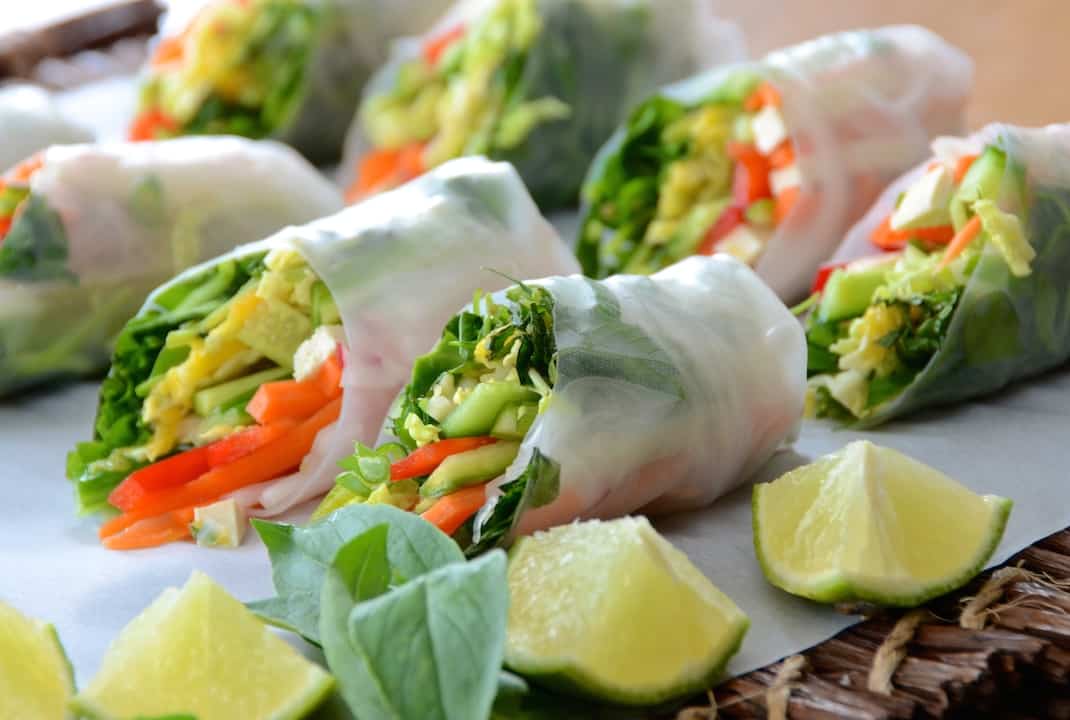
Vegetarian Spring Roll Is A Must-try Vegan Vietnamese Food – Source: Internet - Bún Chay: Bún chay is a vibrant noodle salad. It combines vermicelli noodles, crisp vegetables, herbs, and protein sources such as marinated tofu. The dish is elevated with a zesty dressing, creating a symphony of flavors and textures.
Personalizing Vegan Choices at Vietnamese Eateries
To make your dining experience more tailored to your preferences, consider the following tips:
- Inquire About Vegan Broths: Broths play a pivotal role in Vietnamese cuisine. When dining at Vietnamese restaurants, inquire if they offer vegan broth options for dishes like phở or noodle soups. An increasing number of establishments cater to vegan preferences by providing flavorful vegetable broths.
- Explore Local Eateries: Don’t restrict yourself solely to vegan restaurants. Many local eateries in Vietnam are accommodating towards vegan requests. Simply communicate your dietary preferences, and they are often willing to create vegan versions of their signature dishes.
Exploring Vegan Vietnamese Menus is a culinary adventure filled with flavor and cultural exploration. With an abundance of choices and the flexibility to personalize your selections, you can savor the diverse world of Vegan Vietnamese Food while immersing yourself in the rich culture and culinary traditions of Vietnam.
You can choose Vietnam vegetables for your vegan diet in your trip.
Dining Tips for Traveling Vegans: Navigating Vegan Dining in Vietnam
For vegan travelers in Vietnam, discovering vegan-friendly dining options is easier than ever. To enhance your Vegan Vietnamese Food experience, here are valuable tips and restaurant suggestions for locating vegan restaurants in Saigon (Ho Chi Minh City) and Hanoi.
Tips for Finding Vegan Restaurants in Vietnam
- Utilize Mobile Apps: Employ smartphone apps such as TripAdvisor, and Google Maps. These apps offer reviews, ratings, and precise locations, simplifying your restaurant search.
- Seek Local Recommendations: Don’t hesitate to ask locals or your accommodation staff for vegan restaurant suggestions. Vietnamese people are friendly and helpful, often guiding you to vegan-friendly establishments.
- Consult Online Forums: Explore online forums like Reddit’s Vietnam travel subreddits or Facebook groups dedicated to vegan travel. These platforms offer insights and hidden gems recommended by fellow travelers.
- Spot “Chay” Signs: In Vietnam, “Chay” denotes vegetarian, often indicating vegetarian and vegan options. While not always entirely vegan, it’s a positive sign of plant-based choices.
- Explore Markets: Vietnamese markets are abundant with fresh produce and street food. Look for “chay” or “rau cải” (vegetables) to identify vegan options at food stalls.
Recommended Vegan Vietnamese Food Restaurant
Now, let’s explore vegan restaurant recommendations in Saigon and Hanoi.
Vegan Vietnamese Restaurants in Saigon
- Hum Vegetarian, Café & Restaurant: HUM stands as a distinguished chain of upscale vegetarian restaurants strategically positioned across three convenient neighborhoods spanning District 1, District 2, and District 3. These establishments have carved a niche in crafting nourishing vegetarian cuisine, exclusively using certified ingredients devoid of MSG. At HUM, an array of delightful flavors is thoughtfully sourced from natural origins, resulting in the creation of exceptional and freshly prepared dishes. Complementing the delectable cuisine, HUM also takes pride in its exceptionally captivating interior decor. Furthermore, the restaurant offers a selection of aromatic hot teas and sweet soups to enhance your dining experience.
- Loving Hut Hoa Đăng vegetarian restaurant: Loving Hut, a renowned international brand, boasts a network of over 200 vegan restaurants spanning the globe. In Vietnam, Loving Hut Hoa Dang proudly holds the distinction of being the sole restaurant officially recognized by the Loving Hut Company. Their delectable cuisine is not only vegan but also known for its exceptional taste and use of organic ingredients, offering a delightful and sustainable dining experience. Additionally, they offer a selection of vegan products for customers to purchase and enjoy in the comfort of their own homes.
- Pi Vegan Bistro: Pi Bistro is a Vietnamese vegetarian restaurant that embodies a serene and pure design aesthetic. With a Zen and Buddhist-inspired interior, Pi creates an ideal ambiance for family dining. At Pi Vegetarian Bistro, you’ll discover a harmonious blend of tranquil surroundings and a menu featuring sophisticated Asian cuisine, both in terms of food and beverages.
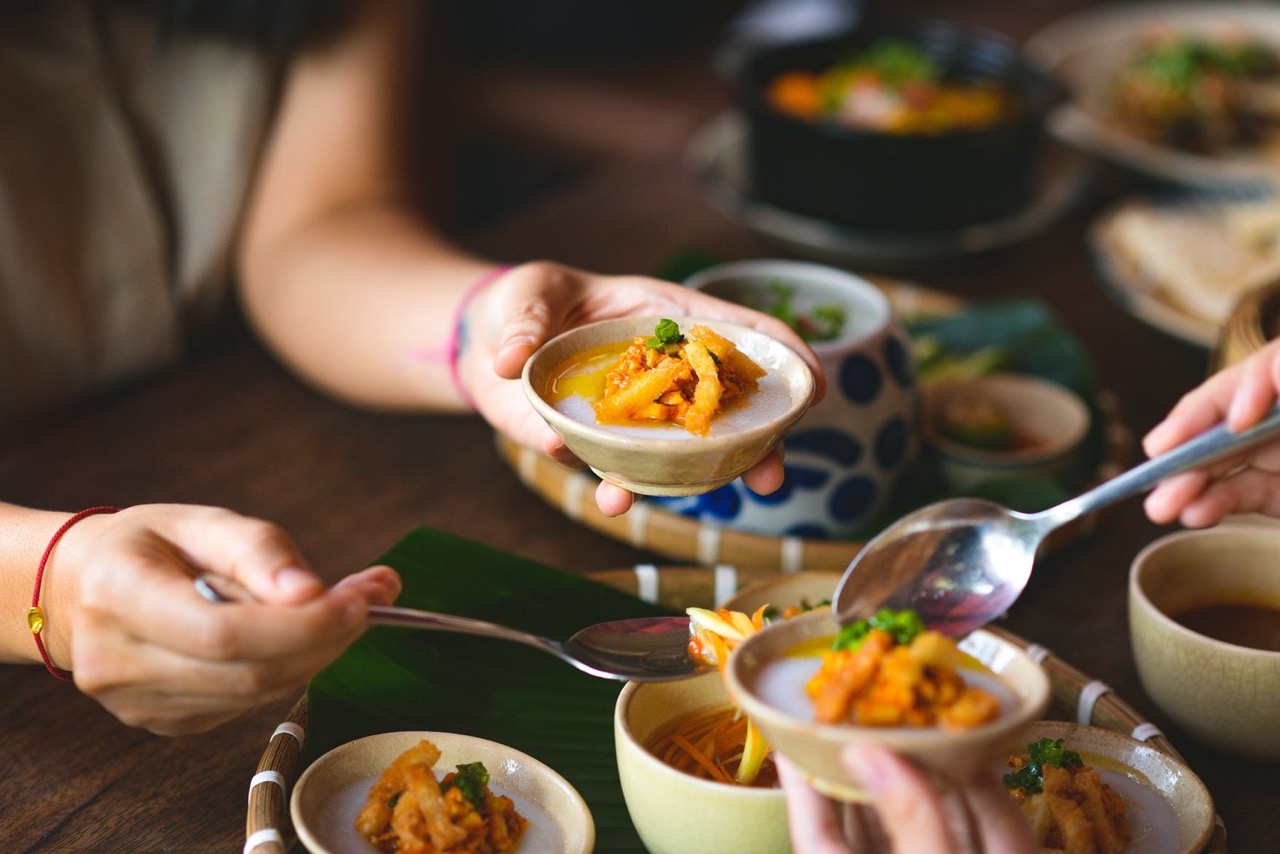
Vietnamese Steamed Rice Cake Is Transformed Into Pi’s Signature Vegetarian Dish – Source: Internet - Sen Vegan House: Sen Vegan House, the town’s cherished and intimate vegetarian restaurant, has a rich history and a focus on Vietnamese-inspired vegan cuisine. Their extensive menu features a variety of fresh salads, noodles, stews, spring rolls, and more, mirroring the daily meals of local residents. A standout specialty is their vegan eggs and meat substitutes, which many find to be even more delightful than their animal-based counterparts.
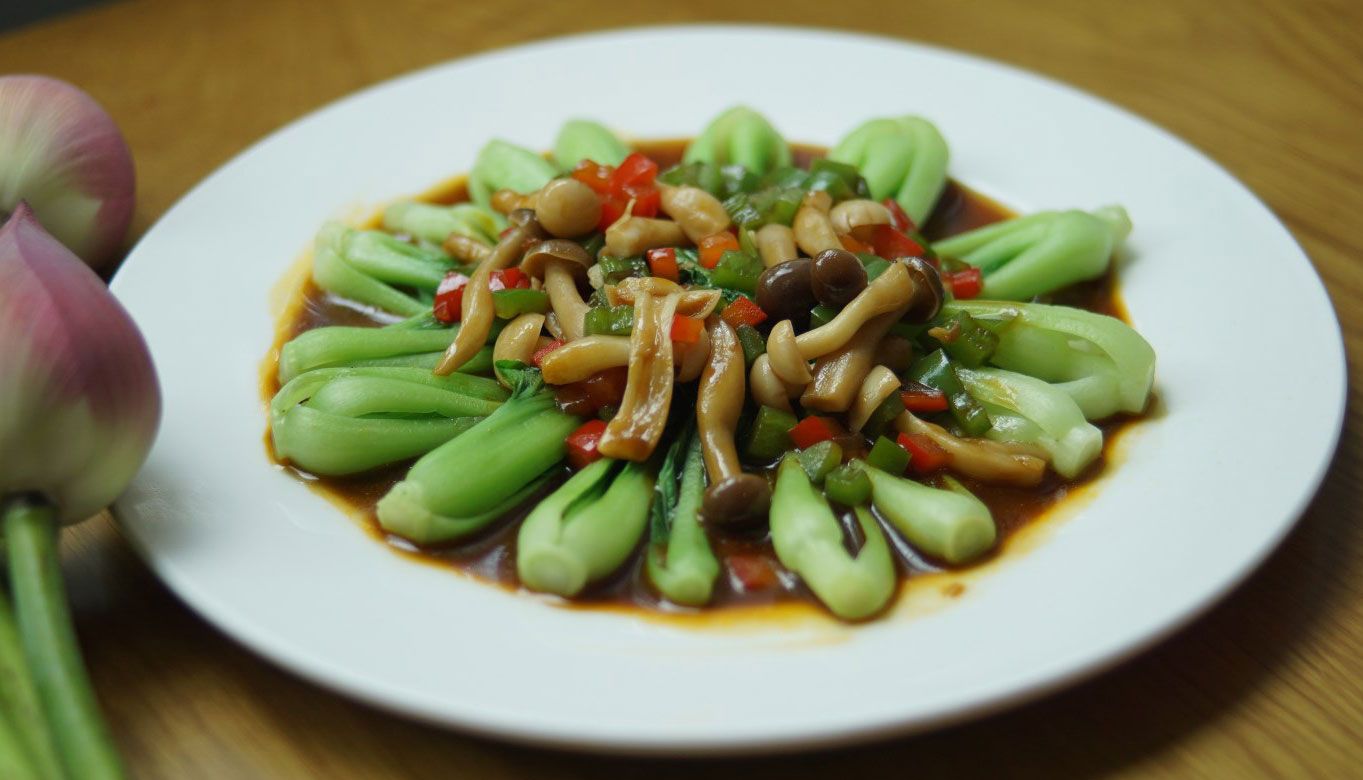
Vegan Vietnamese Restaurants in Hanoi
- Ưu Đàm Vegan Restaurant: Where Vegan Cuisine and Buddhist Philosophy Meet. Step into the serene and inviting ambiance of Ưu Đàm Vegan, where vegan cuisine aligns with the principles of Buddhist philosophy.

Tranquil Buddhist Design At Uu Dam Vegetarian Restaurant – Source: Internet - Nàng Tấm Vegetarian Restaurant: Nang Tam proudly stands as Hanoi’s pioneer Vegetarian Rice Restaurant, boasting over two decades of culinary expertise. Our dedication to crafting vegetarian dishes with authentic Vietnamese flavors aims to present diners with Vegetarian Rice as a culinary art deeply rooted in our national cultural identity. This culinary tradition is not only rich but also exceptionally well-suited to modern life.
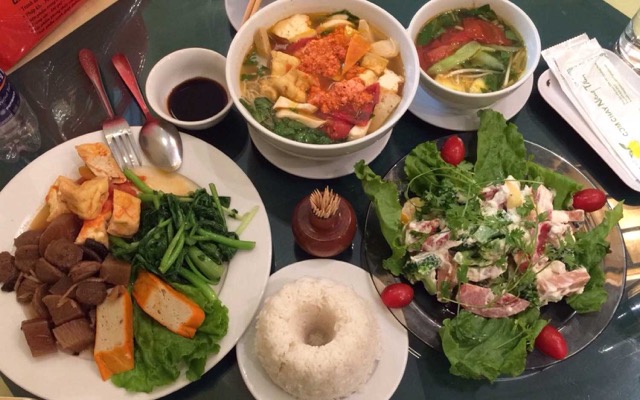
- Bo De Vegan: Bo De Vegan, situated on Quan Su Street amidst the bustling and densely populated neighborhood, stands as a beloved family-owned vegetarian restaurant known for its comforting home-cooked dishes. The menu at Bo De encompasses a diverse array of rice, noodle, and vegetable dishes, which may vary daily. Guests have the option to choose from both buffet and rice plates, creating an immersive experience in the tranquil and pure ambiance inspired by Buddhism. The restaurant is characterized by its dedicated and attentive service staff, ensuring a pleasant dining experience. Don’t forget to conclude your meal with their special tea, crafted from the beloved Asian spice, pandan leaf.
Banh Cam (Orange Cake or Vietnamese Sesame Balls) is a vegan dessert that you should try.
Cooking Vegan Vietnamese at Home
Vietnamese cuisine is renowned for its captivating blend of flavors and the freshness of its ingredients. Fortunately, you can embark on a culinary adventure in the comfort of your own kitchen with Vegan Vietnamese Food.
Homemade Vegan Vietnamese Recipes
Vegan Phở (Phở Chay)
- Ingredients
- Vegan phở broth (store-bought or homemade)
- Rice noodles
- Sliced and marinated tofu or tempeh
- Bean sprouts
- Fresh herbs (Thai basil, cilantro, mint)
- Lime wedges
- Hoisin sauce and sriracha (optional)
- Instructions
- Vegetable Broth:
- If you don’t want to use store-bought broth, you can make your own at home.
- Grill onions and ginger until fragrant, then turn off the heat.
- Add 2.5 liters of filtered water to a pot, and bring it to a boil.
- Reduce heat, add white radish, carrots, corn, chayote, grilled onions, and ginger.
- Simmer for 1 hour, add a teaspoon of salt.
- Regularly skim off foam for a clear broth.
- Cook the rice noodles following the package instructions and set them aside.
- Heat the vegan phở broth in a separate pot.
- Pan-fry the marinated tofu or tempeh in a pan until it’s golden.
- Assemble your bowl: Start with noodles, add tofu/tempeh, and pour the hot broth over them.
- Serve it with bean sprouts, fresh herbs, lime wedges, and condiments like hoisin sauce and sriracha for customization.
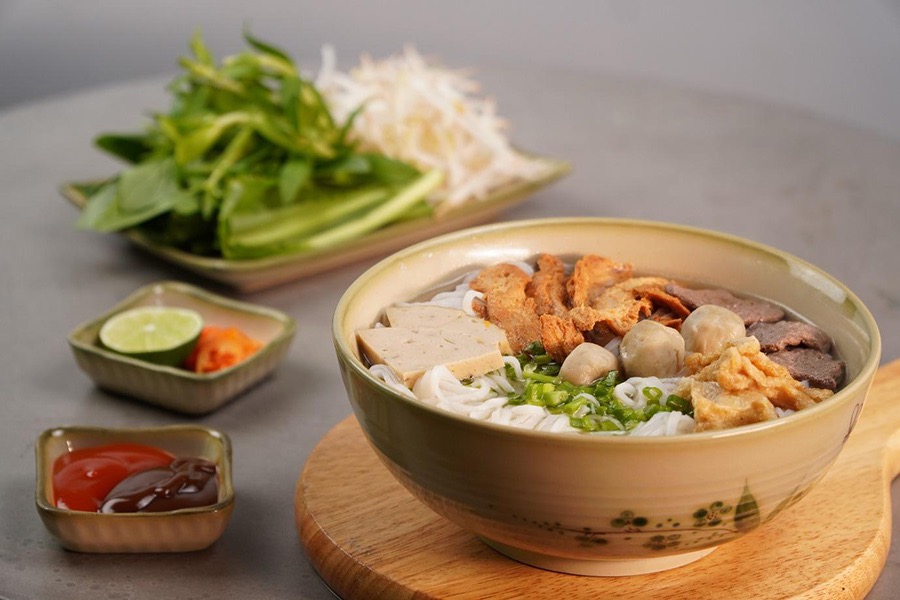
If You Are A Vegetarian, Pho Chay Will Be A Worth-Trying Food – Source: Internet
- Vegetable Broth:
Vegan Bánh Mì (Bánh Mì Chay)
- Ingredients:
- Baguette or bread roll
- Marinated tofu or seitan

Seitan Is A Popular Plant-Based Protein for Vegetarians – Source: Internet - Fresh herbs (cilantro, mint)
- Pickled daikon and carrots
- Vegan mayo or tahini sauce
- Cucumber slices
- Instructions:
- Slice the baguette or bread roll lengthwise.
- Spread vegan mayo or tahini sauce on both sides.
- Layer with marinated tofu or seitan, fresh herbs, cucumber slices, and pickled daikon and carrots.
- Grill or toast the sandwich if desired, then serve.
Essential Ingredients for Vegan Cooking in Vietnam
- Rice Noodles: These form the base for various dishes like phở and bún chay.
- Tofu and Seitan: Commonly used protein sources, marinating them elevates their flavor.
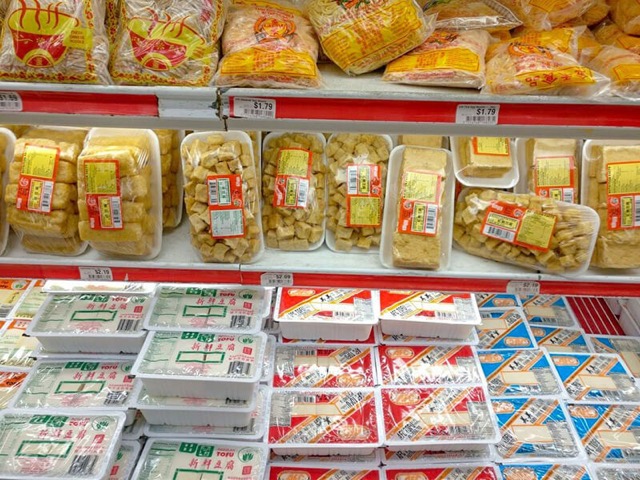
Tofu Is A Vegan Ingredient That Is Very Easy To Buy In Market – Source: Internet - Fresh Herbs: Thai basil, cilantro, and mint add freshness and aroma.
- Lime and Lime Leaves: Lime adds tanginess, while lime leaves infuse a citrusy fragrance.
- Bean Sprouts: These provide a delightful crunch and texture.
- Pickled Daikon and Carrots: A sweet and tangy contrast essential for bánh mì.
- Hoisin Sauce and Sriracha: Condiments that enhance flavor and add a touch of spice.
- Coconut Milk: Adds creaminess to dishes like curries and desserts.
- Rice Paper: Vital for creating fresh spring rolls (gỏi cuốn)
- Vietnamese Rice Paper Wrappers: Used for making crispy spring rolls, and other fried delicacies.
Cooking Vegan Vietnamese Food at home is an opportunity to relish the exquisite flavors of Vietnamese cuisine while adhering to a plant-based diet. With these recipes and essential ingredients, you can recreate the allure of Vegan Vietnam in your own kitchen. The harmonious blend of aromatic herbs, savory notes, and fresh elements awaits your culinary exploration.
Conclusion
In conclusion, vegan Vietnamese cuisine offers a rich tapestry of flavors and cultural experiences. From savory phở to delectable bánh mì, it’s a culinary journey waiting to be explored. We invite you to immerse yourself in the charm of vegan Vietnamese food and embark on a delightful culinary adventure in Vietnam.
Frequently Asked Questions
Q1: How to make Vietnamese pickled vegetables?
A1: To make Vietnamese pickled vegetables, you can follow these steps:
- Prepare a variety of vegetables such as carrots, daikon radish, cucumber, and cabbage.
- Wash and peel the vegetables as necessary. Cut them into thin, uniform slices or julienne strips.
- In a bowl, mix together vinegar, sugar, salt, and warm water until the sugar and salt dissolve.
- Place the vegetables in a clean jar or container and pour the vinegar mixture over them.
- Make sure the vegetables are fully submerged in the liquid. You can use a weight or a clean, food-safe object to keep them submerged.
- Cover the jar or container and let it sit at room temperature for a few hours, or refrigerate for a day or two to allow the flavors to develop.
- Once the pickled vegetables have reached the desired taste, they are ready to be enjoyed. They can be served as a side dish, added to banh mi sandwiches, or used in other Vietnamese dishes.
Q2: How to make Vietnamese vegetable soup?
A2: To make Vietnamese vegetable soup, you can follow this recipe:
- Heat some oil in a pot and add minced garlic and chopped onions. Sauté until fragrant.
- Add vegetable broth or water to the pot and bring it to a boil.
- Add a variety of vegetables such as carrots, cabbage, mushrooms, bok choy, and bean sprouts. You can also add tofu or seitan for protein if desired.
- Season the soup with soy sauce, salt, and pepper to taste. You can also add some vegetable-based seasoning or herbs like cilantro or basil for added flavor.
- Simmer the soup until the vegetables are tender but still retain their crunchiness.
- Adjust the seasoning if needed and serve the Vietnamese vegetable soup hot. It can be enjoyed as a light and healthy meal on its own or served with rice or noodles.
Q3: How to say “vegetables” in Vietnamese?
A3: The word for “vegetables” in Vietnamese is “rau cải.” It is pronounced as “row kai.”
Q4: Where to buy Vietnamese pickled vegetables?
A4: Vietnamese pickled vegetables can be found in various places in Vietnam, including local markets, grocery stores, and specialty food shops. You can also find them at some Vietnamese restaurants or street food vendors. If you’re looking to buy them outside Vietnam, you may try searching for Vietnamese grocery stores or online platforms that specialize in Asian or Vietnamese food products.


Related Posts
How To Get To Mekong Delta From Ho Chi Minh City?
The Southwest of Vietnam is known for its sweet, fragrant fruits, stunning natural landscapes, and welcoming locals. However, for a complete experience, visitors must carefully consider how to get to Mekong Delta from Ho Chi Minh City, as the right choice of transport can significantly enhance your journey. Join Joy Journeys to discover this trip’s […]
Memorable Fruit Picking Experience In Mekong Delta Orchards
Southwest Vietnam is a captivating region known for its expansive rivers, vibrant floating markets, and rich cultural diversity. Fruit picking in Mekong Delta orchards is among the most authentic activities to enjoy while visiting this lush area. Join Joy Journeys to uncover this fertile land’s unique and unforgettable experiences! Top 5 famous fruit orchards in […]
(Amazing) Cu Chi Tunnels Experience For Claustrophobic Visitors
The Cu Chi Tunnels, a vast network stretching over 250 kilometers, are one of Vietnam’s most fascinating historical sites. However, since the tunnels were dug by hand, they can be narrow and dark, which might cause discomfort for some visitors, especially those with claustrophobia. Despite this, the Cu Chi Tunnels remain a safe and captivating […]